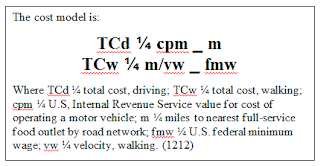This article
discusses the correlation between the locations of grocery stores with healthy
food, compared to the locations of non-grocery stores that sell unhealthy food
and how close they are to resident’s homes. Unhealthy eating habits have been
at an increase since people started realizing how “fat” Americans were becoming
and the up rise in childhood diabetes. When research was conducted on the small
town of Lawrence, Kansas, it was found that there are many cities in the U.S where
there are no grocery stores within a 5 mile radius of people’s homes. These
places are considered to be a “food desert’s” [which] is the name established
for specific locations with “poor access to affordable, healthful food” (1210).
There are stores such as gas stations or food outlets in these areas, but the
food offered is not of significant nutritional value.
Other factors that were
considered in this study were the modes of transportation used to get from the
people’s homes to the food source location. Divided into four groups were
people who walked, people who took public transportation, people who were
driven and people who drove themselves. The conclusion the scientists came to
when factoring in modes of transportation was that the “extent of the food
desert is very different for people who travel on foot, by public
transportation, and by private automobile as is the scale and time of their
journey”(1215). And depending on the
type of transportation used there were limiting factors: if you were walking
you can only carry so many bags of groceries, if you rode the bus you were also
limited by the amount of groceries you could take, if you had a ride you were
limited by the amount of time the person had available to take you to the store
and what you were able to get, and if you had your own car you had to pay for
gas meaning less money for food.
Specifically for
this study “a cost model was created to calculate the cost variation between
the distance from the stores, the mode of transportation, and income” (1212). Using the data calculated by this
cost model, the researchers were able to conclude that there are many factors
that limit how close healthful food is to a particular area. Factors such as
income level, the amount of people that own vehicles, and location of the city
all contribute to the lack of healthy food.
Works Cited
Lucious
F. Hallett IV, D. M. (2010). Qantifying the Extent and Cost of Food Deserts in
Lawrence, Kansas, USA. Applied Geography, 1210-1216.



This is a very interesting article. I am doing my research on the socio-economic factors that play into consumer satisfaction at farmers' markets in both the rural and urban setting. This same type of anaylsis would be extremely helpful for my project.
ReplyDeleteFood deserts are a very interesting phenomena. My home town has a big problem with them, and over the past few years the city has been working with various grocery stores to try and fix it. This type of analysis is my favorite part of GIS, because it is so interesting and it spans so many fields of study. It would be interesting to look at the correlation between childhood obesity and food deserts, and see if their is an additional correlation between childhood obesity and the amount of fast food places in an area.
ReplyDeleteThe location chosen for this study is very interesting to me. I had always thought of food deserts affecting people in larger cities, such as LA, but it seems that they would affect smaller cities with a lower concentrated population, thus less grocery stores. This visual depiction of this very serious social issue is incredibly effective and hopefully could lead the way to access of food to areas that truly need it. It would also be interesting to overlay the fast food restaurants in the area, to see was what the access to cheaper, less nutritious, and lower quality food is, comparatively.
ReplyDelete